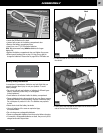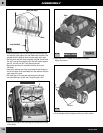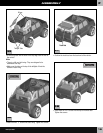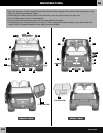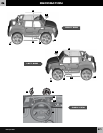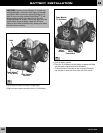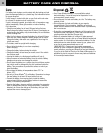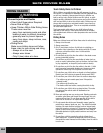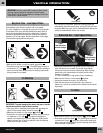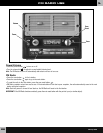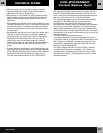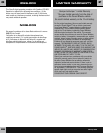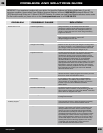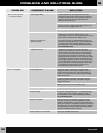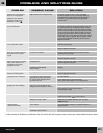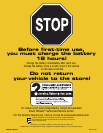
VEHICLE CARE
M
• Check all screws, cap nuts and their protective coverings
regularly and tighten as required. Check plastic parts on a
regular basis for cracks or broken pieces.
• During snowy or rainy weather, the vehicle should be stored
inside or under a protective cover. Remember to charge the
battery at least once per month while your vehicle is not in
regular use.
• Avoid operating the vehicle in wet or snowy conditions, and do
not spray the vehicle with a hose. Do not wash the vehicle with
soap and water. Water or moisture in the motors or electrical
switches can cause them to corrode, and could cause switch
or motor failure.
• Avoid operating the vehicle on sand, loose dirt or gravel. Sand,
loose dirt or gravel in the motors or electrical switches can
cause them to jam, and could cause switch or motor failure.
• The vehicle can be wiped down with a soft, dry cloth. For
a shiny finish, you can wipe plastic parts with a non-wax
furniture polish applied to a soft-cloth. Do not use automotive
wax. Do not use soap and water or spray the vehicle with
a hose.
• To ensure that your vehicle stays in good operating order, we
recommend that you periodically have your vehicle checked by
a Power Wheels
®
authorized service center. For the location of
the authorized service center nearest you, please visit us
on-line at www.powerwheels.com or call 1-800-348-0751.
N
FCC STATEMENT
(United States Only)
This equipment has been tested and found to comply with the
limits for a Class B digital device, pursuant to Part 15 of the FCC
Rules. These limits are designed to provide reasonable protection
against harmful interference in a residential installation.
This equipment generates, uses and can radiate radio frequency
energy and, if not installed and used in accordance with
the instructions, may cause harmful interference to radio
communications. However, there is no guarantee that interference
will not occur in a particular installation. If this equipment does
cause harmful interference to radio or television reception, which
can be determined by turning the equipment off and on, the user is
encouraged to try to correct the interference by one or more of the
following measures:
• Reorient or relocate the receiving antenna.
• Increase the separation between the equipment and receiver.
• Consult the dealer or an experienced radio/TV technician for help.
Note: Changes or modifications not expressly approved by the
manufacturer responsible for compliance could void the user’s
authority to operate the equipment.
This device complies with Part 15 of the FCC Rules. Operation
is subject to the following two conditions: (1) this device may
not cause harmful interference and (2) this device must accept
any interference received, including interference that may cause
undesired operation.
27
N8417pr-0920



